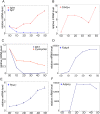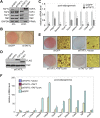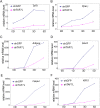Dual functions of TAF7L in adipocyte differentiation
- PMID: 23326641
- PMCID: PMC3539393
- DOI: 10.7554/eLife.00170
Dual functions of TAF7L in adipocyte differentiation
Abstract
The diverse transcriptional mechanisms governing cellular differentiation and development of mammalian tissue remains poorly understood. Here we report that TAF7L, a paralogue of TFIID subunit TAF7, is enriched in adipocytes and white fat tissue (WAT) in mouse. Depletion of TAF7L reduced adipocyte-specific gene expression, compromised adipocyte differentiation, and WAT development as well. Ectopic expression of TAF7L in myoblasts reprograms these muscle precursors into adipocytes upon induction. Genome-wide mRNA-seq expression profiling and ChIP-seq binding studies confirmed that TAF7L is required for activating adipocyte-specific genes via a dual mechanism wherein it interacts with PPARγ at enhancers and TBP/Pol II at core promoters. In vitro binding studies confirmed that TAF7L forms complexes with both TBP and PPARγ. These findings suggest that TAF7L plays an integral role in adipocyte gene expression by targeting enhancers as a cofactor for PPARγ and promoters as a component of the core transcriptional machinery.DOI:http://dx.doi.org/10.7554/eLife.00170.001.
Keywords: C3H10T½; ChIP-seq; Mouse; RNA-seq; TAF7L; adipogenesis; differentiation.
Conflict of interest statement
Robert Tjian is President of the Howard Hughes Medical Institute (2009–present), one of the three founding funders of
The remaining authors have declared that no competing interests exist.
Figures












References
-
- Akinloye O, Gromoll J, Callies C, Nieschlag E, Simoni M. 2007. Mutation analysis of the X-chromosome linked, testis-specific TAF7L gene in spermatogenic failure. Andrologia 39:190–5 - PubMed
-
- Armstrong JD, Coffey MT, Esbenshade KL, Campbell RM, Heimer EP. 1994. Concentrations of hormones and metabolites, estimates of metabolism, performance, and reproductive performance of sows actively immunized against growth hormone-releasing factor. J Anim Sci 72:1570–7 - PubMed
-
- Boergesen M, Pedersen TA, Gross B, van Heeringen SJ, Hagenbeek D, Bindesboll C, et al. 2012. Genome-wide profiling of liver X receptor, retinoid X receptor, and peroxisome proliferator-activated receptor alpha in mouse liver reveals extensive sharing of binding sites. Mol Cell Biol 32:852–67 - PMC - PubMed
-
- Bowers RR, Lane MD. 2008. Wnt signaling and adipocyte lineage commitment. Cell Cycle 7:1191–6 - PubMed
-
- Brun RP, Kim JB, Hu E, Altiok S, Spiegelman BM. 1996. Adipocyte differentiation: a transcriptional regulatory cascade. Curr Opin Cell Biol 8:826–32 - PubMed
Publication types
MeSH terms
Substances
Grants and funding
LinkOut - more resources
Full Text Sources
Other Literature Sources
Molecular Biology Databases

